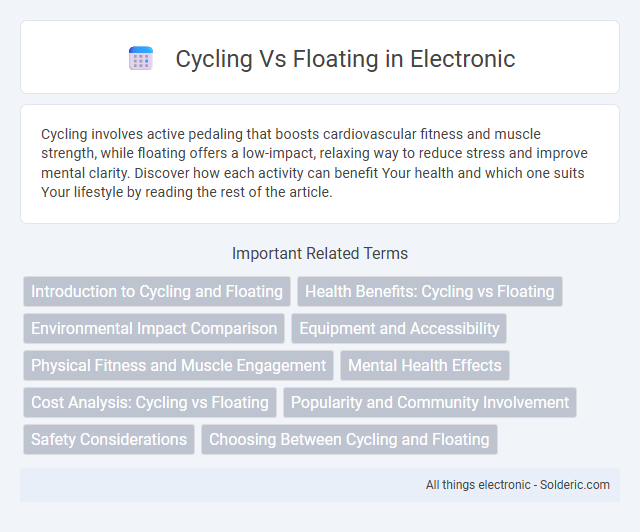Cycling involves active pedaling that boosts cardiovascular fitness and muscle strength, while floating offers a low-impact, relaxing way to reduce stress and improve mental clarity. Discover how each activity can benefit Your health and which one suits Your lifestyle by reading the rest of the article.
Comparison Table
| Aspect | Cycling | Floating |
|---|---|---|
| Definition | Physical activity using a bicycle for transport, sport, or recreation | Relaxation technique involving floating in a sensory deprivation tank |
| Primary Benefit | Improves cardiovascular fitness and muscle strength | Reduces stress and promotes mental relaxation |
| Physical Impact | High, weight-bearing exercise | Low, non-weight-bearing and passive |
| Calorie Burn | High, typically 400-700 calories/hour | Minimal, primarily mental relaxation |
| Equipment Needed | Bicycle, helmet, cycling gear | Float tank or sensory deprivation pod |
| Typical Duration | 30 minutes to 2 hours | 45 minutes to 1 hour |
| Target Audience | Fitness enthusiasts, commuters, athletes | Individuals seeking stress relief and mindfulness |
Introduction to Cycling and Floating
Cycling involves repetitive aerobic exercise on a stationary bike or road bike, boosting cardiovascular health, muscle endurance, and calorie burn. Floating, also known as floatation therapy, entails lying in a sensory deprivation tank filled with salt water to promote relaxation, stress relief, and muscle recovery. Your choice depends on whether you seek high-intensity physical training or restorative mental and physical relaxation.
Health Benefits: Cycling vs Floating
Cycling enhances cardiovascular health by improving heart and lung function while strengthening muscles and boosting endurance through consistent aerobic exercise. Floating promotes mental well-being by reducing stress hormones, alleviating muscle tension, and supporting recovery via sensory deprivation and deep relaxation. Incorporating both activities into Your routine balances physical fitness with mental restoration for comprehensive health benefits.
Environmental Impact Comparison
Cycling produces minimal carbon emissions, relying solely on human power, making it one of the most environmentally friendly transportation modes. Floating devices such as kayaks or paddleboards have a low ecological footprint, but their impact varies depending on the material composition and manufacturing processes. Both activities promote sustainable interaction with natural environments, though cycling offers greater efficiency for long-distance travel with nearly zero environmental degradation.
Equipment and Accessibility
Cycling requires specialized equipment such as a bike, helmet, and appropriate clothing, making it accessible in urban and rural areas with bike paths or roads. Floating, often done in pools or natural water bodies, demands minimal gear like swimsuits and can be accessible to individuals of all ages and fitness levels. Your choice depends on the availability of equipment and the ease of access to safe cycling routes or suitable floating locations.
Physical Fitness and Muscle Engagement
Cycling primarily targets lower body muscles such as the quadriceps, hamstrings, and calves, enhancing cardiovascular endurance and muscular strength through repetitive pedaling motions. Floating, often associated with low-impact water exercise or flotation therapy, minimizes muscle strain while promoting relaxation and joint mobility, engaging core muscles subtly without intense exertion. Comparing both, cycling delivers more robust physical fitness benefits by actively building muscle endurance and cardiovascular health, whereas floating supports recovery and flexibility with lower muscle engagement intensity.
Mental Health Effects
Cycling improves mental health by reducing stress, anxiety, and depression through the release of endorphins and increased exposure to natural environments. Floating, also known as sensory deprivation, promotes relaxation and boosts mood by decreasing cortisol levels and enhancing mindfulness. Both activities offer distinct mental health benefits, with cycling providing active engagement and floating supporting deep mental calmness.
Cost Analysis: Cycling vs Floating
Cycling involves significant upfront costs including equipment, maintenance, and safety gear, while floating typically requires lower initial investment primarily for flotation devices or access to floatation facilities. Over time, cycling may incur higher ongoing expenses due to repairs, replacement parts, and fuel or electricity if using an e-bike, whereas floating costs are usually limited to occasional facility fees or minimal equipment upkeep. Your choice should consider both the initial financial commitment and long-term operational costs to determine which activity aligns best with your budget.
Popularity and Community Involvement
Cycling boasts a larger global community with millions of enthusiasts participating in events, group rides, and cycling clubs that foster social interaction and shared goals. Floating, while growing in popularity due to wellness trends, maintains a smaller, niche community focused on relaxation and mindfulness experiences rather than competitive or social group activities. Your engagement in cycling offers a more dynamic social environment, whereas floating provides a solitary, introspective retreat favored by wellness seekers.
Safety Considerations
Cycling involves continuous movement that requires constant attention to traffic rules, road conditions, and protective gear like helmets to minimize injury risks. Floating on water demands awareness of water currents, weather conditions, and appropriate flotation devices to ensure safety. Your choice should prioritize the environment you feel most confident navigating while using the right safety equipment for the activity.
Choosing Between Cycling and Floating
Choosing between cycling and floating depends on your fitness goals and physical condition. Cycling improves cardiovascular endurance, strengthens leg muscles, and burns calories effectively, making it ideal for weight management and enhancing overall stamina. Floating, especially in sensory deprivation tanks, promotes relaxation, reduces stress, and aids muscle recovery without physical exertion, benefiting mental clarity and rehabilitation.
Cycling vs floating Infographic

 solderic.com
solderic.com